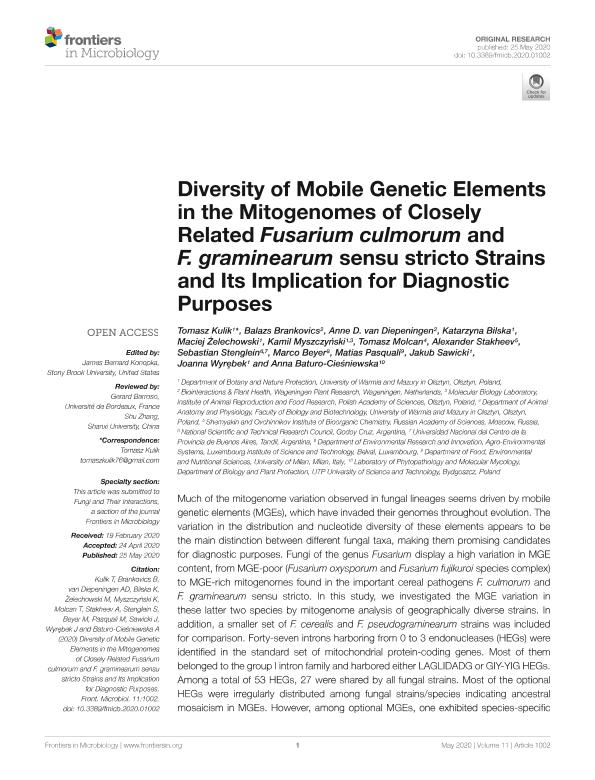Mostrar el registro sencillo del ítem
dc.contributor.author
Kulik, Tomasz
dc.contributor.author
Brankovics, Balazs
dc.contributor.author
Van Diepeningen, Anne D.
dc.contributor.author
Bilska, Katarzyna
dc.contributor.author
Zelechowski, Maciej
dc.contributor.author
Myszczyński, Kamil
dc.contributor.author
Molcan, Tomasz
dc.contributor.author
Stakheev. Alexander
dc.contributor.author
Stenglein, Sebastian Alberto

dc.contributor.author
Beyer, Marco
dc.contributor.author
Pasquali, Matias
dc.contributor.author
Sawicki, Jakub
dc.contributor.author
Baturo Cieśniewska, Anna
dc.date.available
2020-06-09T20:34:12Z
dc.date.issued
2020-04
dc.identifier.citation
Kulik, Tomasz; Brankovics, Balazs; Van Diepeningen, Anne D.; Bilska, Katarzyna; Zelechowski, Maciej; et al.; Diversity of mobile genetic elements in the mitogenome of closely related Fusarium culmorum and F. graminearum sensu stricto strains ans its implication for diagnostic purposes; Frontiers; Frontiers in Microbiology; 4-2020; 1-14
dc.identifier.issn
1664-302X
dc.identifier.uri
http://hdl.handle.net/11336/107090
dc.description.abstract
Much of the mitogenome variation observed in fungal lineages seems driven by mobile genetic elements (MGEs), which have invaded their genomes throughout evolution. The variation in the distribution and nucleotide diversity of these elements appears to be the main distinction between different fungal taxa, making them promising candidates for diagnostic purposes. Fungi of the genus Fusarium display a high variation in MGE content, from MGE-poor (F. oxysporum and Fusarium fujikuroi species complex) to MGE-rich mitogenomes found in the important cereal pathogens F. culmorum and F. graminearum sensu stricto. In this study, we investigated the MGE variation in these latter two species by mitogenome analysis of geographically diverse strains. In addition, a smaller set of F. cerealis and F. pseudograminearum strains was included for comparison. Forty-seven introns harboring from 0 to 3 endonucleases (HEGs) were identified in the standard set of mitochondrial protein-coding genes. Most of them belonged to the group I intron family and harbored either LAGLIDADG or GIY-YIG HEGs. Among a total of 53 HEGs, 27 were shared by all fungal strains. Most of the optional HEGs were irregularly distributed among fungal strains/species indicating ancestral mosaicism in MGEs. However, among optional MGEs, one exhibited species-specific conservation in F. culmorum. While in F. graminearum s.s. MGE patterns in cox3 and in the intergenic spacer between cox2 and nad4L may facilitate the identification of this species. Thus, our results demonstrate distinctive traits of mitogenomes for diagnostic purposes of Fusaria.
dc.format
application/pdf
dc.language.iso
eng
dc.publisher
Frontiers

dc.rights
info:eu-repo/semantics/openAccess
dc.rights.uri
https://creativecommons.org/licenses/by-nc-sa/2.5/ar/
dc.subject
FUSARIUM SPECIES
dc.subject
MITOGENOME
dc.subject
MITOCHONDRIAL INTRONS
dc.subject
HOMING ENDONUCLEASES
dc.subject
MOBIL GENETICS ELEMENTS
dc.subject.classification
Agronomía, reproducción y protección de plantas

dc.subject.classification
Agricultura, Silvicultura y Pesca

dc.subject.classification
CIENCIAS AGRÍCOLAS

dc.subject.classification
Micología

dc.subject.classification
Ciencias Biológicas

dc.subject.classification
CIENCIAS NATURALES Y EXACTAS

dc.title
Diversity of mobile genetic elements in the mitogenome of closely related Fusarium culmorum and F. graminearum sensu stricto strains ans its implication for diagnostic purposes
dc.type
info:eu-repo/semantics/article
dc.type
info:ar-repo/semantics/artículo
dc.type
info:eu-repo/semantics/publishedVersion
dc.date.updated
2020-05-19T18:50:16Z
dc.journal.pagination
1-14
dc.journal.pais
Suiza

dc.description.fil
Fil: Kulik, Tomasz. Department Of Botany And Nature Protection, University; Polonia
dc.description.fil
Fil: Brankovics, Balazs. Wageningen Plant Research, Wageningen University; Países Bajos
dc.description.fil
Fil: Van Diepeningen, Anne D.. Waneningen Plant Research; Países Bajos
dc.description.fil
Fil: Bilska, Katarzyna. Department Of Botany And Nature Protection, University; Polonia
dc.description.fil
Fil: Zelechowski, Maciej. Department Of Botany And Nature Protection, University; Polonia
dc.description.fil
Fil: Myszczyński, Kamil. Department Of Botany And Nature Protection, University; Polonia
dc.description.fil
Fil: Molcan, Tomasz. Faculty Of Biology And Biotechnology, University; Polonia
dc.description.fil
Fil: Stakheev. Alexander. Institute Of Bioorganic Chemistry (ras); Rusia
dc.description.fil
Fil: Stenglein, Sebastian Alberto. Consejo Nacional de Investigaciones Científicas y Técnicas. Centro Cientifico Tecnolológico Mar del Plata. Instituto de Investigaciones en Biodiversidad y Biotecnología. Laboratorio de Biología Funcional y Biotecnología; Argentina
dc.description.fil
Fil: Beyer, Marco. Luxembourg Institute Of Science And Technology; Luxemburgo
dc.description.fil
Fil: Pasquali, Matias. Faculty Of Agricultural And Food Sciences; Italia
dc.description.fil
Fil: Sawicki, Jakub. Department Of Botany And Nature Protection, University; Polonia
dc.description.fil
Fil: Baturo Cieśniewska, Anna. Baturo-cieśniewska; Polonia
dc.journal.title
Frontiers in Microbiology
dc.relation.alternativeid
info:eu-repo/semantics/altIdentifier/doi/http://dx.doi.org/10.3389/fmicb.2020.01002
dc.relation.alternativeid
info:eu-repo/semantics/altIdentifier/url/https://www.frontiersin.org/articles/10.3389/fmicb.2020.01002/full
Archivos asociados
